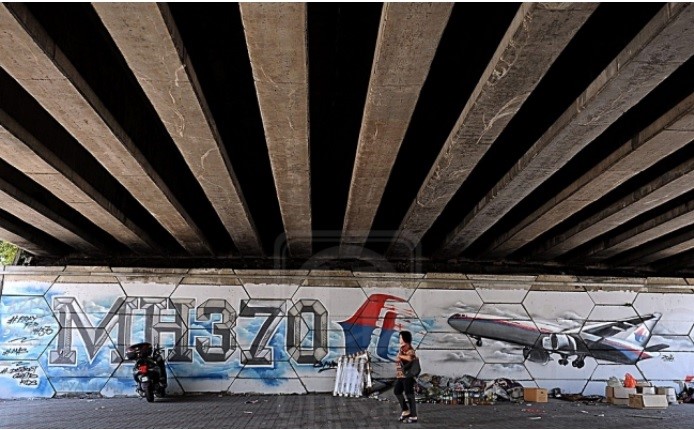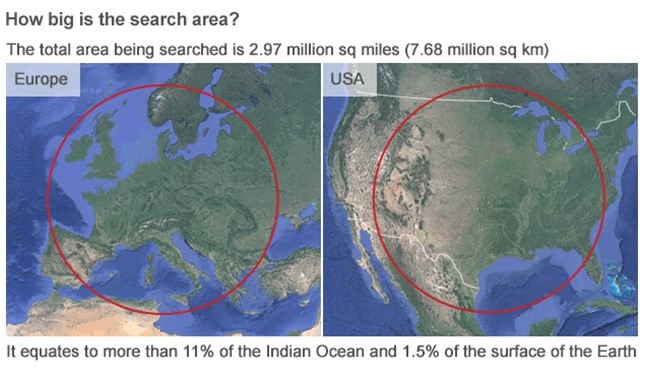by Siti Shafiah binti Abdul Rahim

Link: https://www.utusan.com.my/rencana/utama/setahun-mh370-seorang-pejalan-kaki-melintasi-grafiti-di-bawah-1.66564
Recently, we have marked the date of MH370 lost who’s now reached its 5 years of missing aircraft. Without even knowing where the aircraft or the passengers are, this is a huge mystery that leaves everybody in grief and pain. There have been maximum efforts of the Search and Rescue (SAR) mission by Malaysian Government with the cooperation of three committed countries, China and Australia.
Back to the beginning 5 years ago, The Star Online (2014) reported Malaysia Airlines (MAS) flight MH370 carrying 227 passengers from 14 nations and 12 Malaysian crew members was missing on its way from Kuala Lumpur to Beijing after departed on 8th March 2014 at 12.41am. According to Berita Harian news dated 19th of March 2014, Flight MH370 was scheduled to arrive in Beijing at 6.40 am, but the signal of Flight MH370 has disappeared from the Malaysia’s Department of Civil Aviation at 1.30 am. The aircraft however, did not enter Chinese airspace or contacted the Chinese controllers (Abu Bakar, Hamzah, & Muhammad, 2014).
What happens during the first few weeks of the incident was a tough time for Malaysian Government and Malaysia Airlines to deal with the press conferences and foreign media. The press conferences were conducted every half an hour after the plane disappearance was reported. The pressure comes from non-stop media coverage from various local and foreign media agencies who seek for latest information of the missing aircraft.
Those days, Malaysia steals the worlds’ attention where MAS also released statements and latest information on Facebook and Twitter allowing thousands of shares and comments praying for the passengers’ safety (Mohd Nazri Latiff Azmi, Nur Ain Afizan Abd Rahman, Zulazhan Abd. Halim & Mohd Fauzi Abdul Hamid, 2016).
The reporting has triggered many speculations and theories of the missing flight that might satisfy readers who has been demanded for answers. However, it did not the affect the efforts to continue solving the mystery and clarifications has been made towards the rumours by Malaysia Airlines and the Malaysian Governments.
Mohd Nazri Latiff Azmi, Nur Ain Afizan Abd Rahman, Zulazhan Abd. Halim & Mohd Fauzi Abdul Hamid (2016) mentioned that the SAR mission was aided by aircrafts and technologies from many countries like China, the United States and Australia. Led by the Malaysian authorities, numerous surveillance planes and jets equipped with sensors and electro-optics detectors, and foreign aviation experties were on the ground to help the rescue mission at the last missing location reported, the Indian Ocean. Apart form that, the Earth-monitoring satellites provided by China giving the crew a clear overlook on the searching mission.
The mission was later joined by other foreign countries to offers further investigation and detailed satellite data analysis for the Malaysian authorities. From the situation, we have seen how leaders of involved countries deals with the international crisis until they had to learn in-depth of the aviation industry (Weaver, 2014).
Dealing with the family members of the victims was one of the challenges in this tragedy. According to Junaidi Abu Bakar, Mohd Sahandri Gani bin Hamzah, Mazura Mastura Muhammad (2014), they were given accomodation, foods and other necessities paid by Malaysian Government and also legal aid to assists burden regarding insurance, liability, procedure and et cetera by a team of lawyers from the Malaysian Bar Council. This includes councelling services for the mourning families that were provided by Ministry of Women, Family and Community Development.
Mohd Nazri Latiff Azmi, Nur Ain Afizan Abd Rahman, Zulazhan Abd. Halim & Mohd Fauzi Abdul Hamid (2016) mentioned that they also received continuous support from foreign countries when the Australian Hotels Association give their accommodations to the families of Flight MH370 passengers to witness the recovery area and to be at the closest where the plane is believed to have jumped into the ocean. The victim’s familieswere transported to Perth, Australia by the Malaysia Airlines flight. “There is an agreement of the memorandum of understanding between Malaysia and Australia, in providing high technology equipment needed, during the search of MH370”, said them.
After 327 days of searching, the Malaysian Government concluded that the aircraft exhausted its fuel over a defined area of the southern Indian Ocean, and that the aircraft is located on the sea floor close to that defined area. Therefore on 28 January 2015, the Government of Malaysia officially declare Malaysia Airlines flight MH370 an accident and with the heaviest heart and deepest sorrow, all 239 of the passengers and crew onboard MH370 are presumed to have lost their lives. (Department of Civil Aviation Malaysia, 2015)
As a lesson to the crossed borders tragedy like MH370, an international cooperation is necessary to be reinforced and expanded with a MoU for countries to be able to exchange information during the tough times to ease investigation and avoid any geopolitic issues. (Suparta, 2015) This case may be referred as an example of crisis management and international communication between countries and becoming one of the world’s greatest aviation mysteries.
Amazingly, the search for a missing airplane has united the all knowledge, military assets and 21 satellites from Malaysia, China and Autralia. When the SAR mission was announce to stop, it came out that the total searched area for MH370 flight Boeing 777-200 covers about 7.68 million sq km equates to more than 11% of the Indian Ocean and 1.5% of the Earth surface. (Astro Awani, 2014) What an interesting fact here.

Link: http://www.astroawani.com/berita-malaysia/mh370-apa-yang-telah-kita-belajar-daripada-kehilangan-pesawat-ini-32436
References
Abu Bakar, J., Hamzah, M., & Muhammad, M. (2014). Crisis Management- Malaysian Aviation Tragedies. International Conference on Innovative Trends in Multidisciplinary Academic Research, 33-46.
Astro Awani. (2014, Mac 24). MH370: Apa yang telah kita belajar daripada kehilangan pesawat ini? Retrieved Mac 25, 2019, from Astro Awani: http://www.astroawani.com/berita-malaysia/mh370-apa-yang-telah-kita-belajar-daripada-kehilangan-pesawat-ini-32436
Department of Civil Aviation Malaysia. (2015, January 29). Announcement on MH370 by Director General Department of Civil Aviation Malaysia. Retrieved Mac 25, 2019, from http://www.mh370.gov.my/images/phocadownload/doa_announcement.pdf
Junaidi Abu Bakar, Mohd Sahandri Gani bin Hamzah, Mazura Mastura Muhammad. (2014). Crisis Management – Malaysian Aviation Tragedies. GlobalIlluminators, 86-87.
Mohd Nazri Latiff Azmi, Nur Ain Afizan Abd Rahman, Zulazhan Abd. Halim & Mohd Fauzi Abdul Hamid. (2016). Crisis Management in Communication: A Study onMH370, MH17 and QZ8501 Aviation Tragedies. Journal of Communication Media Watch, 285.
Suparta, W. (2015, Mac 7). Setahun Kehilangan MH370. Retrieved Mac 25, 2019, from Utusan Online: https://www.researchgate.net/profile/Wayan_Suparta/publication/274069096_Setahun_kehilangan_MH370_-_Rencana_-_Utusan_Online/links/5513ed310cf23203199ccab9/Setahun-kehilangan-MH370-Rencana-Utusan-Online.pdf
The Star Online. (2014, Mac 8). Flight MH370 bound for Beijing goes missing. Retrieved 7 24, 2019, from The Star Online: https://www.thestar.com.my/news/nation/2014/03/08/missing-plane-mas/
Weaver, M. &. (2014, March 12). MH370: China releases satellite images of possible crash site. Retrieved July 24, 2019, from The Guardian: https://www.theguardian.com/world/blog/2014/mar/12/mh370-search-extended-into-andaman-sea-live-updates